CHEVROLET BLAZER 1993 Service Manual
Manufacturer: CHEVROLET, Model Year: 1993, Model line: BLAZER, Model: CHEVROLET BLAZER 1993Pages: 386, PDF Size: 20.7 MB
Page 41 of 386
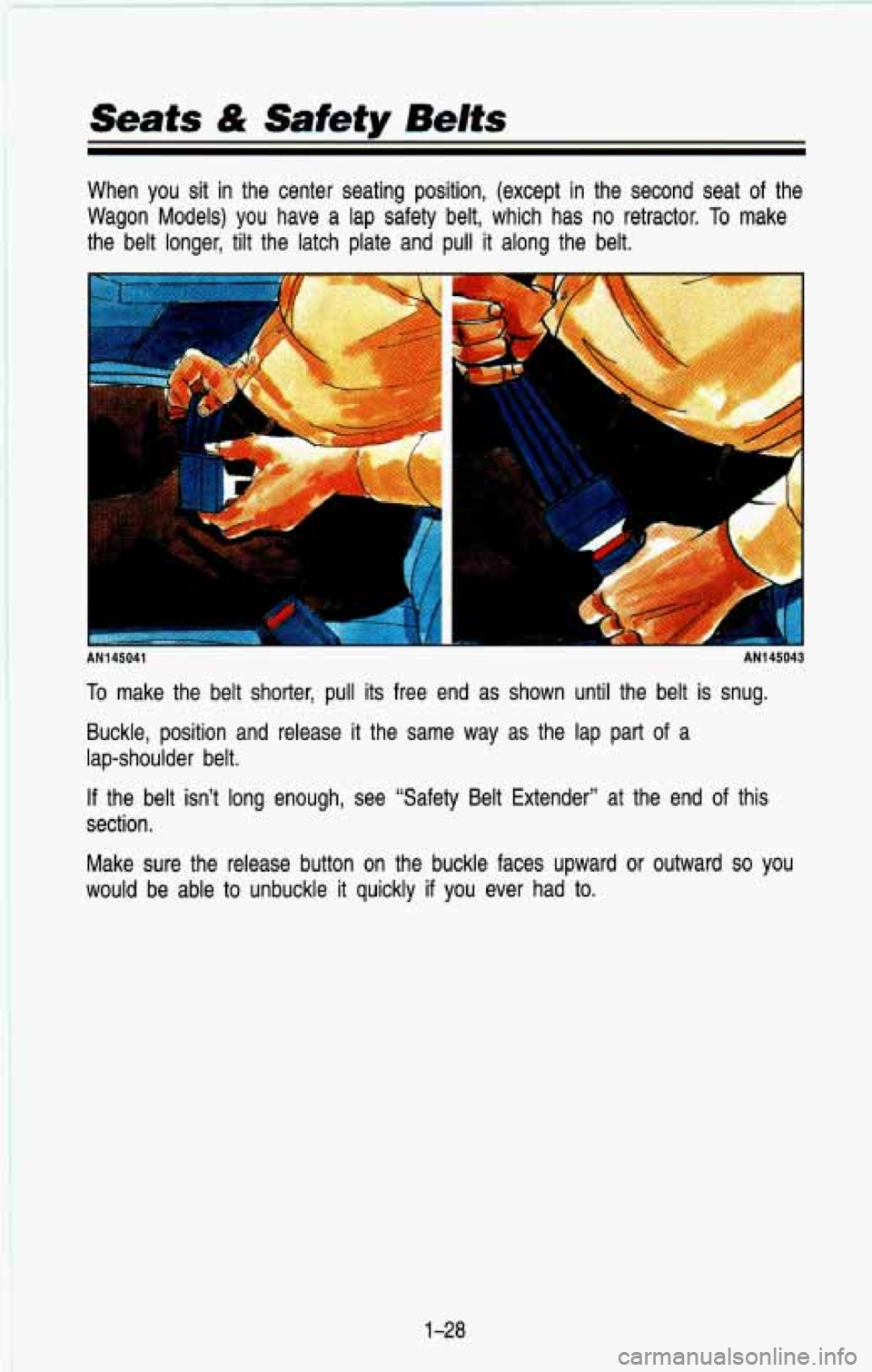
- Seats & Safety Belts
When you sit in the center seating position, (except in the second seat of the
Wagon Models) you have a lap safety belt, which has no retractor.
To make
the belt longer, tilt the latch plate and pull it along the \
belt.
I AN145041 AN145043
To make the belt shorter, pull its free end as shown until the belt is snug.
Buckle, position and release
it the same way as the lap part of a
lap-shoulder belt.
If the belt isn’t long enough, see “Safety Belt Extender’’\
at the end of this
section.
Make sure the release button on the buckle faces upward or ou\
tward
so you
would be able to unbuckle
it quickly if you ever had to.
1-28
Page 42 of 386
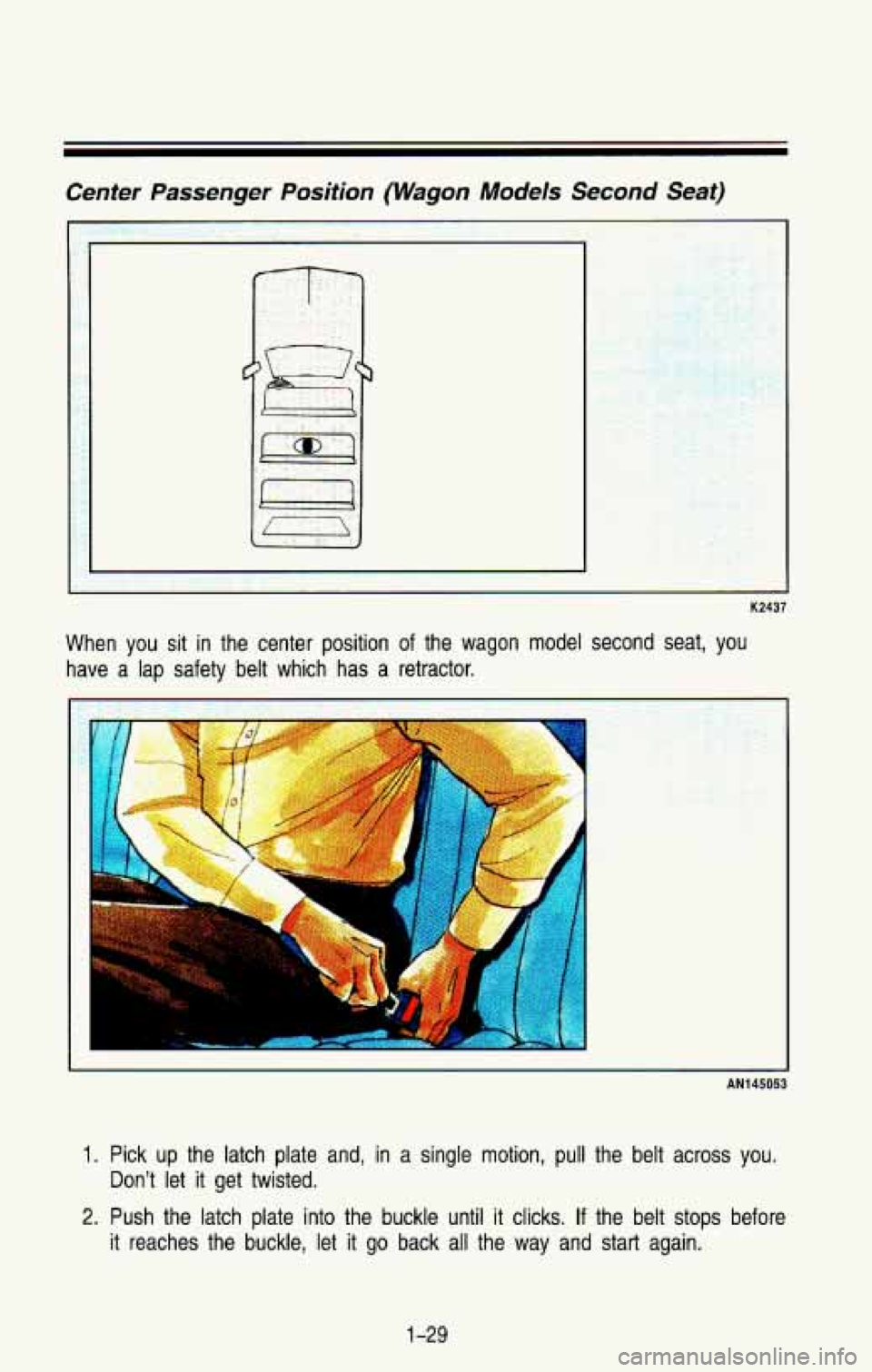
Center Passenger Position (Wagon Models Second Seat)
K2437
When you sit in the center position of the wagon model second seat, you
have a lap safety belt which has a retractor.
r
.. .. .
AN145053
I. Pick up the latch plate and, in a single motion, pull the belt across you.
2. Push the latch plate into the buckle until it clicks. If the belt stops before
Don’t let
it get twisted.
it reaches the buckle, let it go back all the way and start again.
1-29
Page 43 of 386
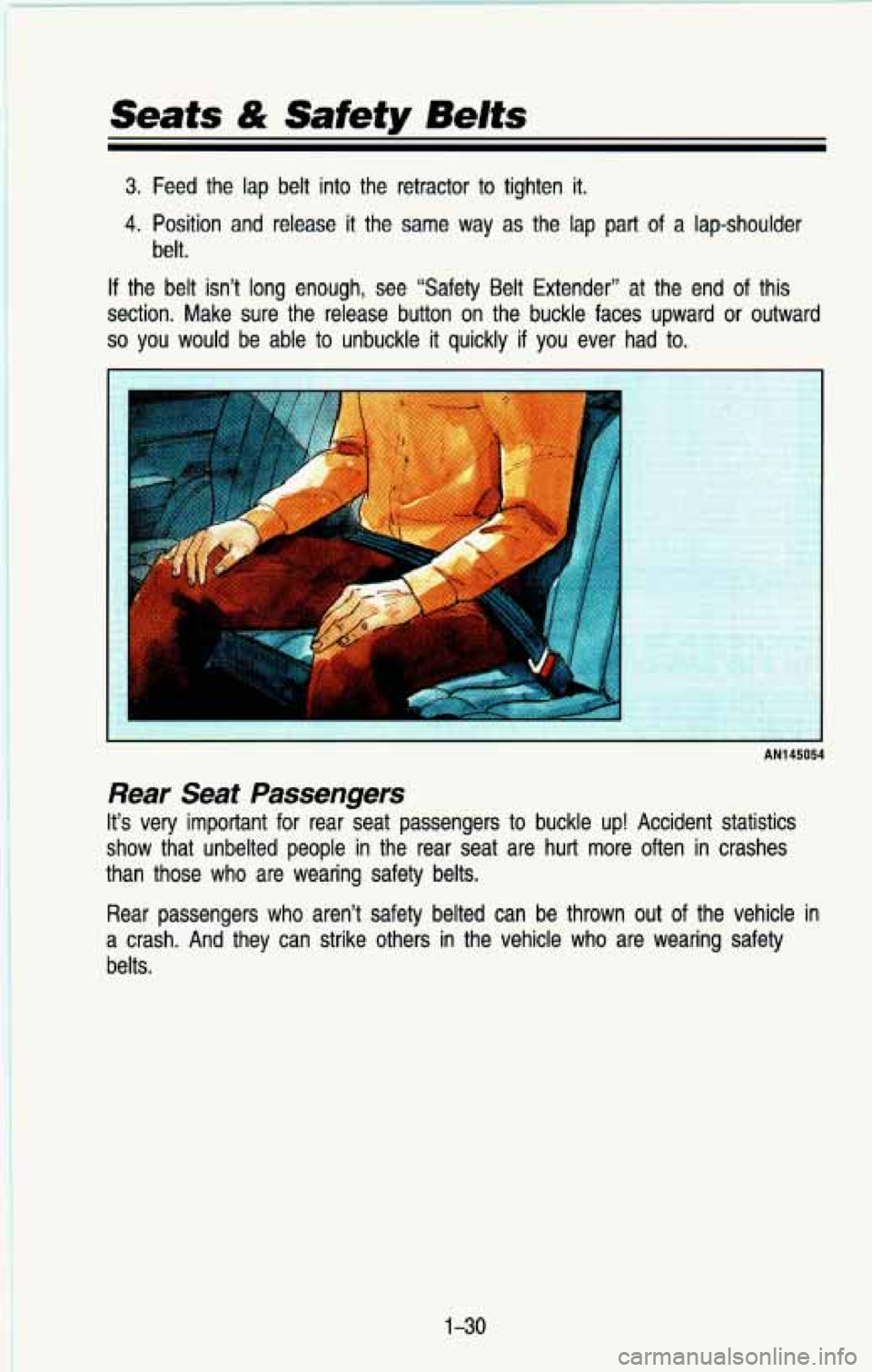
Seats & Safety Belts
3. Feed the lap belt into the retractor to tighten it.
4. Position and release it the same way as the lap part of a lap-shoulder
belt.
If the belt isn’t long enough, see “Safety Belt Extender” \
at the end of this
section. Make sure the release button on the buckle faces upwa\
rd or outward
so you would be able to unbuckle it quickly if you ever had to.
AN145054
Rear Seat Passengers
It’s very important for rear seat passengers to buckle up! Accident statistics
show that unbelted people in the rear seat are hurt more often in crashes
than those who are wearing safety belts.
Rear passengers who aren’t safety belted can be thrown out of the vehicle in
a crash. And they can strike others in the vehicle who are wearing safety
belts.
1-30
Page 44 of 386
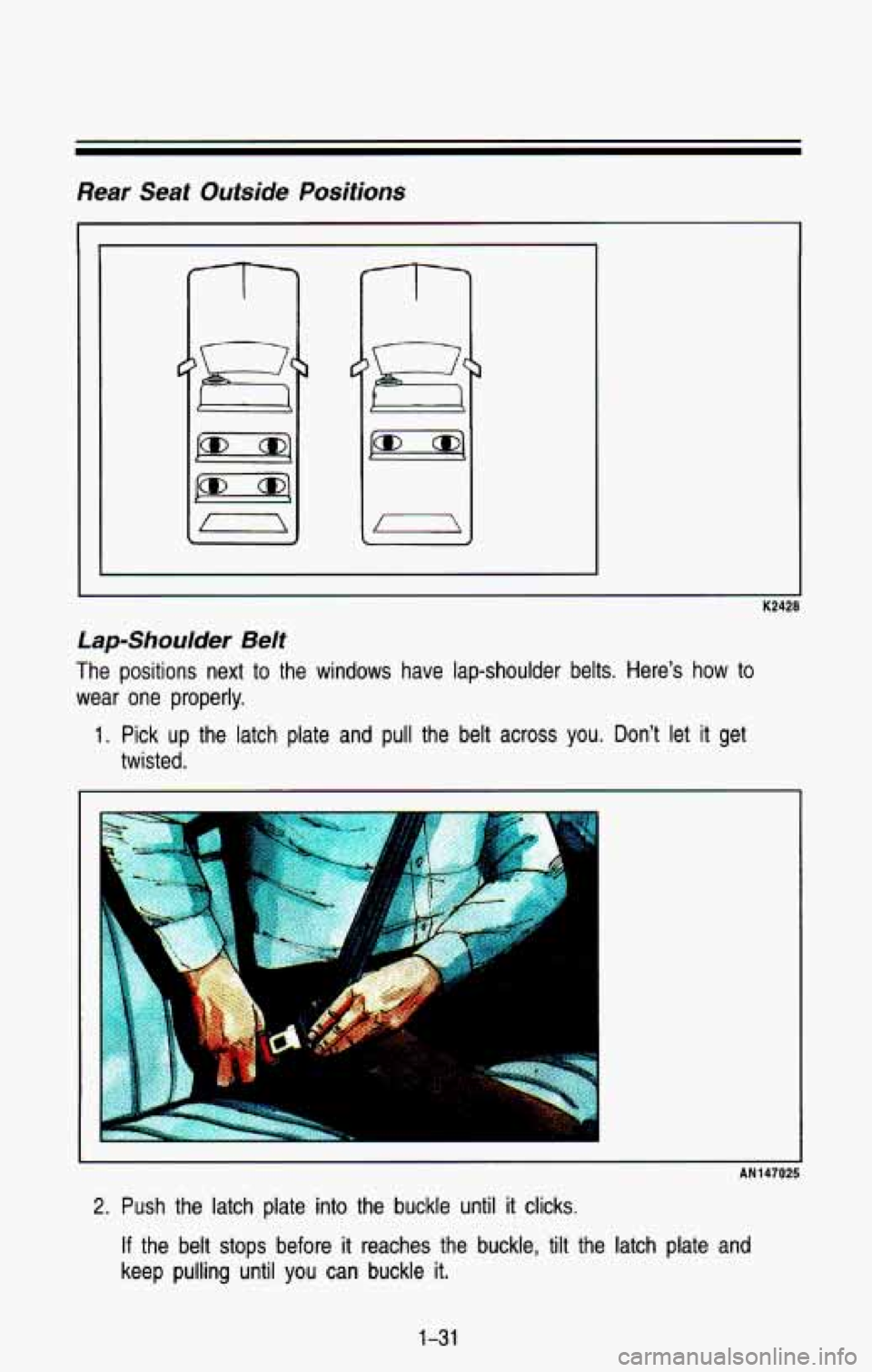
Rear Seat Outside Positions
Lap-Shoulder Belt
The positions next to the windows have lap-shoulder belts. Here’s how to
wear one properly.
1. Pick up the latch plate and pull the belt across you. Don’t let it get\
twisted.
AN14702
2. Push the latch plate into the buckle until it clicks.
If the belt stops before it reaches the buckle, tilt the latch plate and
keep pulling until you can buckle it.
1-31
Page 45 of 386
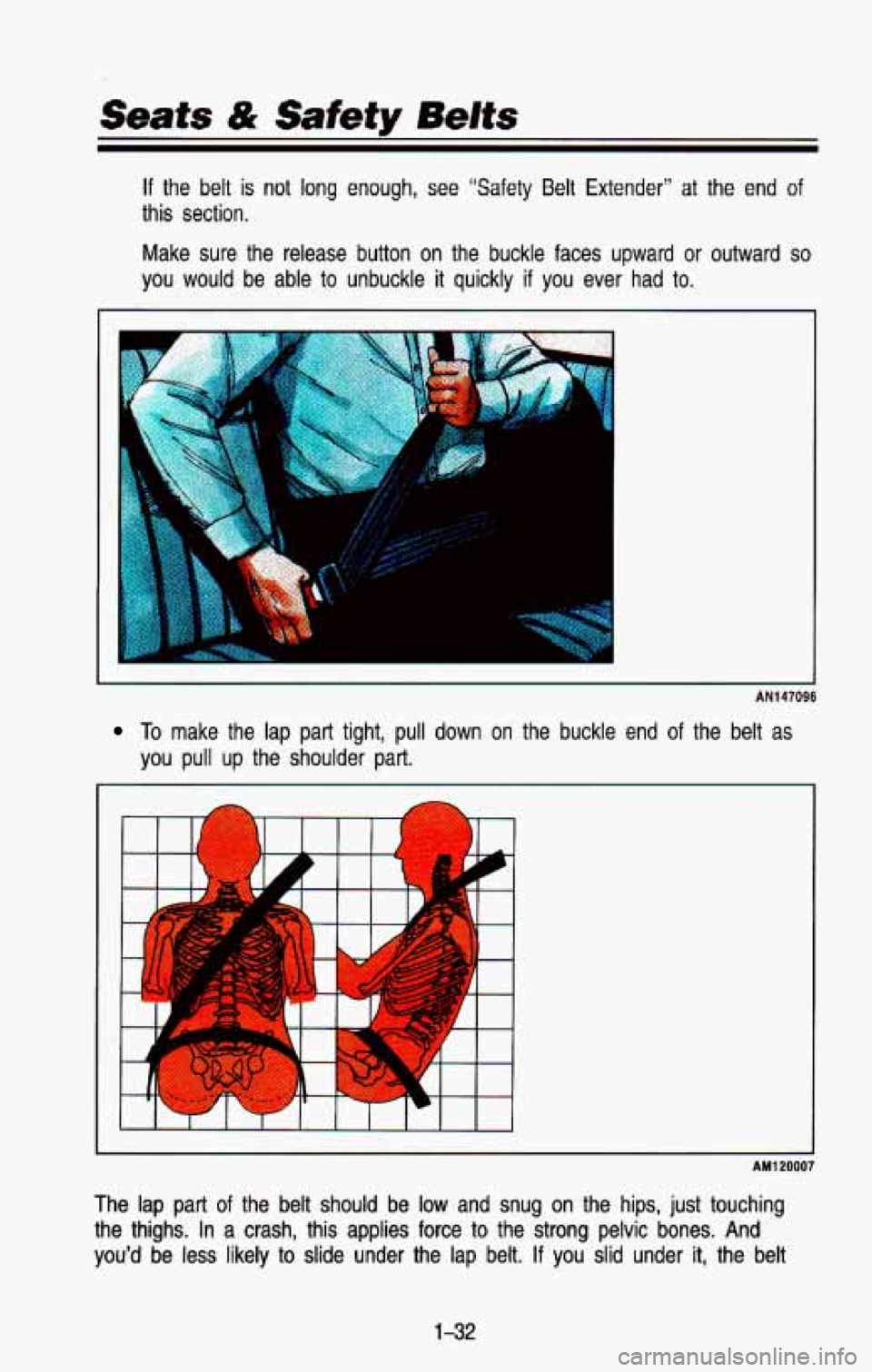
If the belt is not long enough, see “Safety Belt Extender” at the end of
this section. Make
sure the release button on the buckle faces upward or outward so
you would be able to unbuckle it quickly if you ever had to.
AN147096
To make the lap part tight, pull down on the buckle end of the belt as
you pull up the shoulder part.
L
.
1
I1
AM1 20007
The lap part of the belt should be low and snug on the hips, just touching
the thighs. In a crash, this applies force
to the strong pelvic bones. And
you’d be less likely
to slide under the lap belt. If you slid under it, the belt
1-32
Page 46 of 386
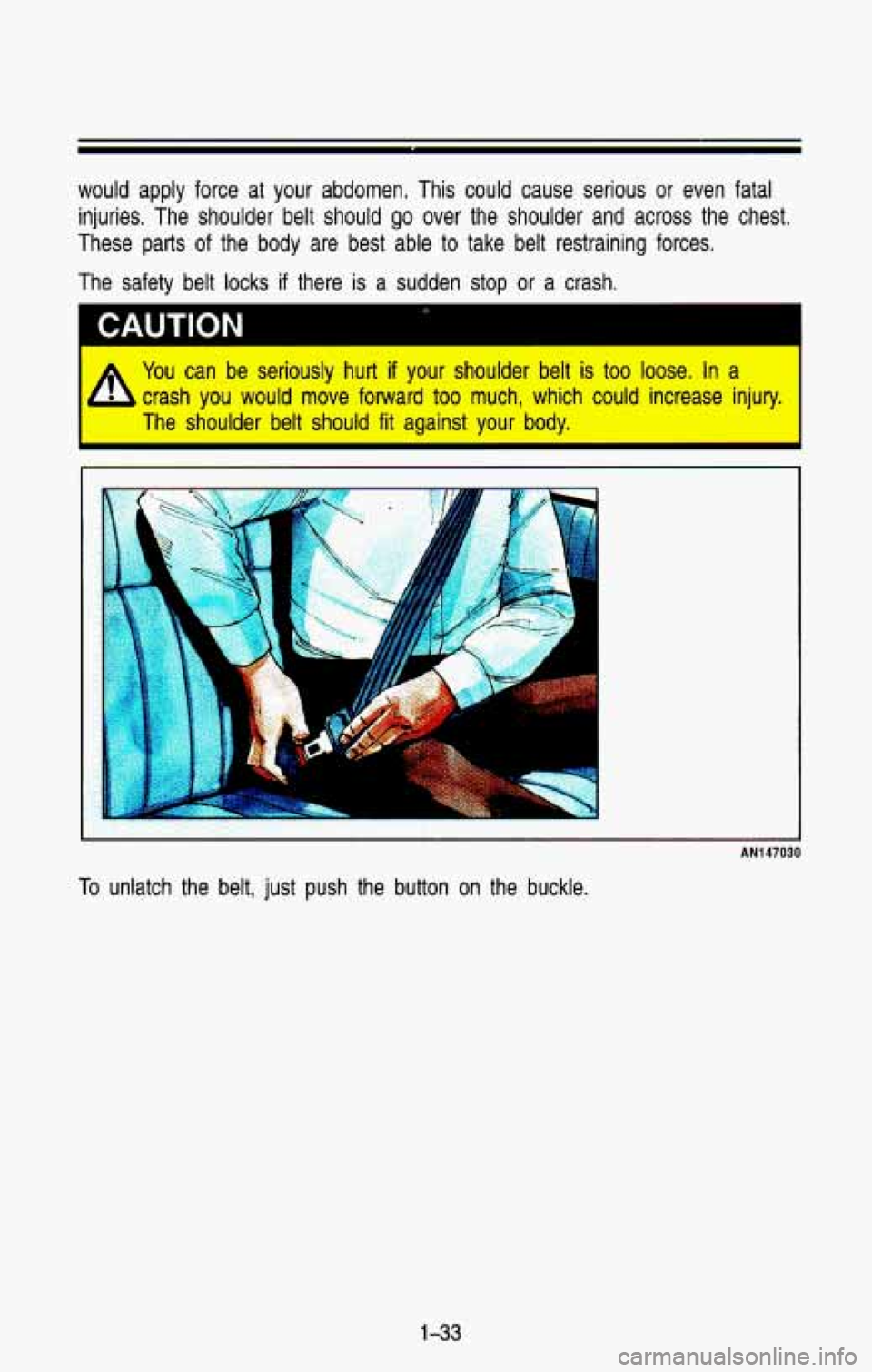
would apply force at your abdomen. This could cause serious or even fatal
injuries. The shoulder belt should go over the shoulder and across the chest.
These parts
of the body are best able to take belt restraining forces.
The safety belt locks
if there is a sudden stop or a crash.
You can be seriously hurt
if your shoulder belt is too loose. In a
The shoulder belt should fit against your body.
'b crash you would move forward too much, which could increase injury.
I L
I CAUTION
r
AN147030
To unlatch the belt, just push the button on the buckle.
1-33
Page 47 of 386
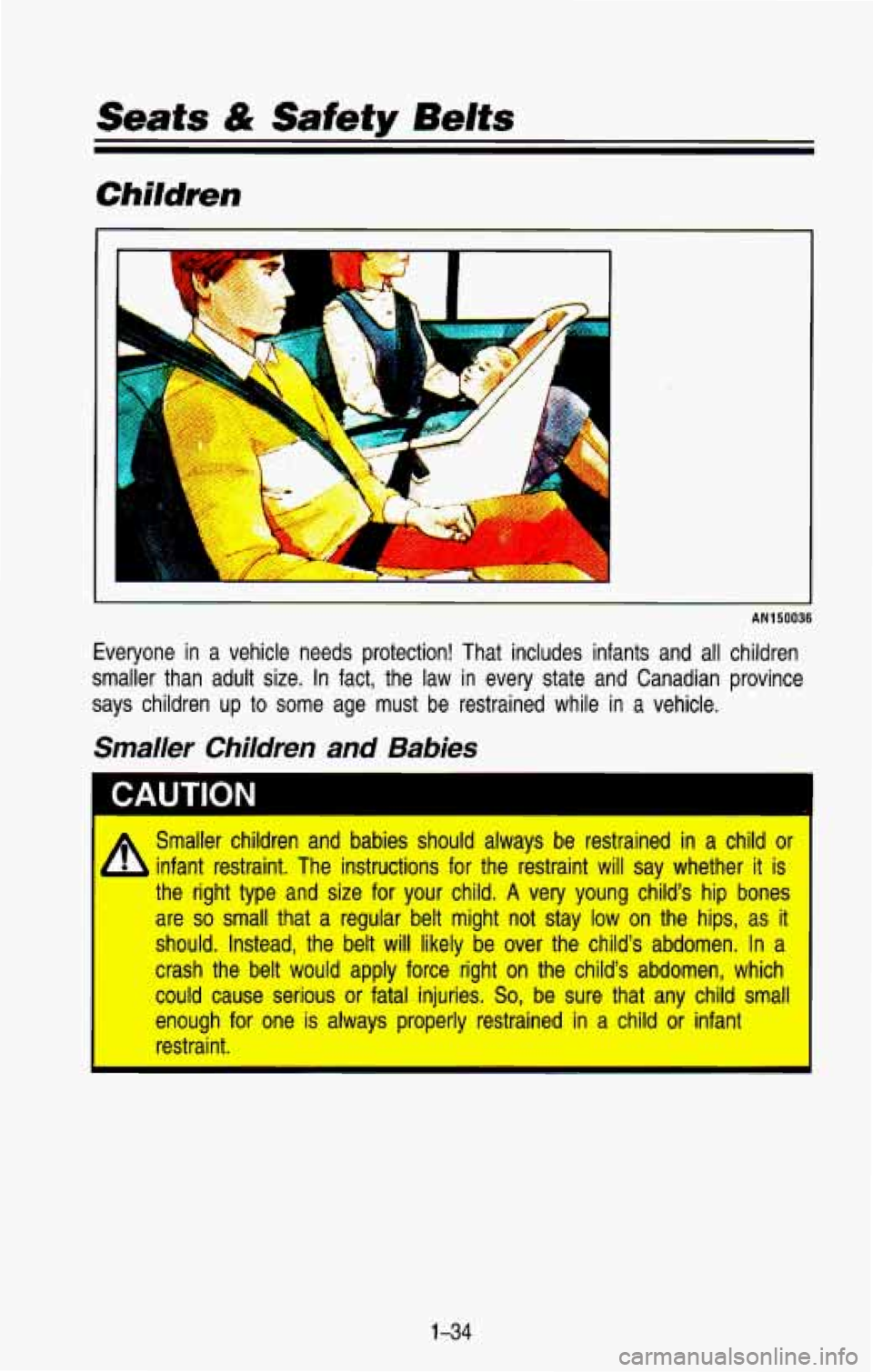
Seats & Safety Belts
AN1 50036
Everyone in a vehicle needs protection! That includes infants and all children
smaller than adult size. In fact, the law in every state and Canadian province
says children up to some age must be restrained while in
a vehicle.
Smaller Children and Babies
CAUTION
I A Smaller children and babies should always be restrained in a child or
b infant restraint. The instructions for the restraint will say whether it is
the right
type and size for your child. A very young child's hip bones
are so small that a regular belt might not stay low on the hips, as it
should. Instead, the belt will likely be over the child's abdomen. In a
crash the belt would apply force right on the child's abdomen, which
could cause serious or fatal injuries. So, be sure that any child small
enough for one is always properly restrained in a child or infant
restraint.
I
134
Page 48 of 386
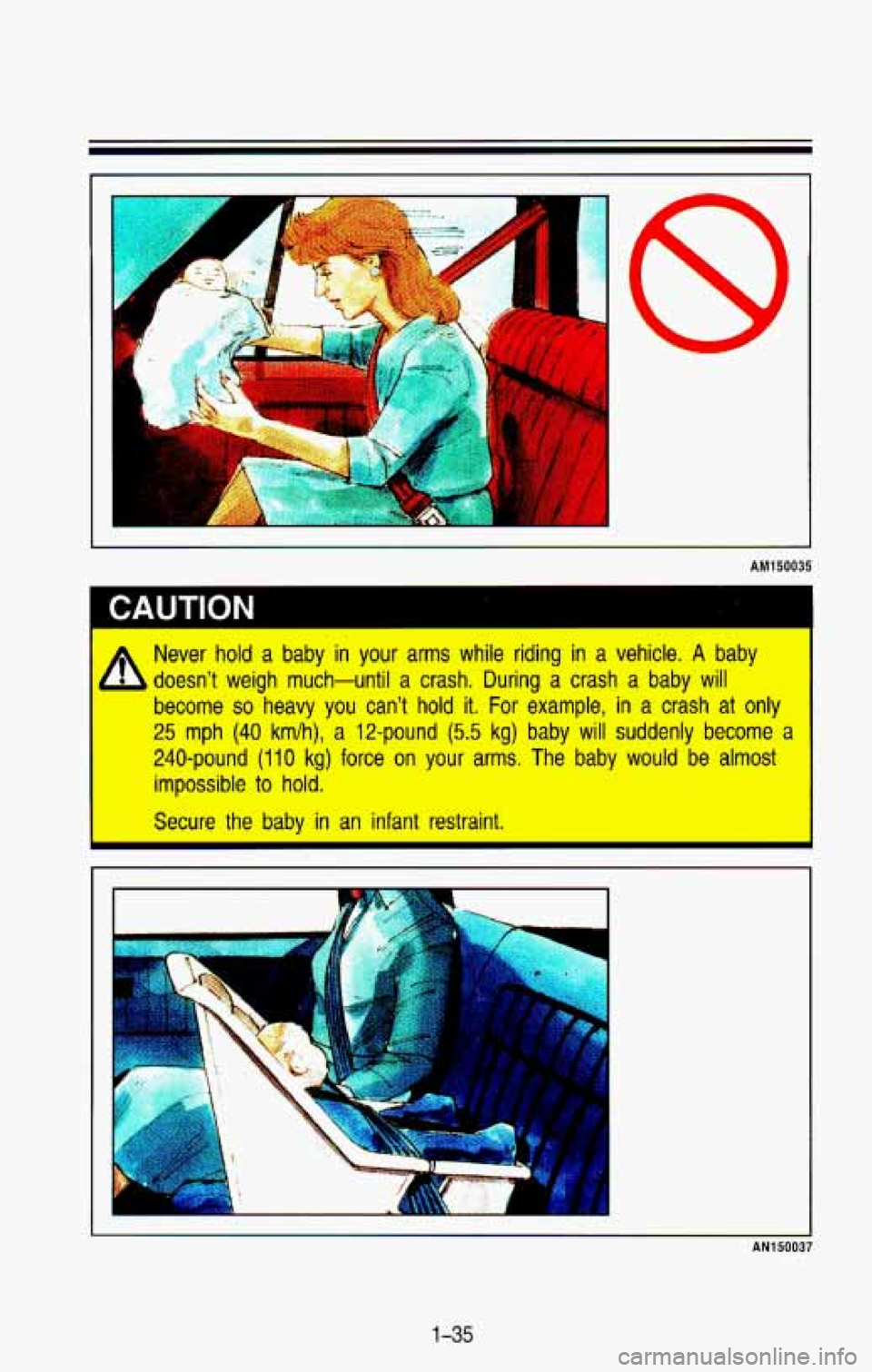
r
A
I-
AM150035
I CAUTION
Never hold a baby in your arms while riding in a vehicle. A baby
doesn't weigh much-until a crash. During a crash a baby
will
become so heavy you can't hold it. For example, in a crash at only
I mph (40 km/h), a 12-pound (5.5 kg} baby will suddenly become a
240-pound
(1 10 kg) force on your arms. The baby would be almost
impossible
to hold.
Secure
the baby in an infant restraint.
I'
I' -4
AN15003
1-35
Page 49 of 386
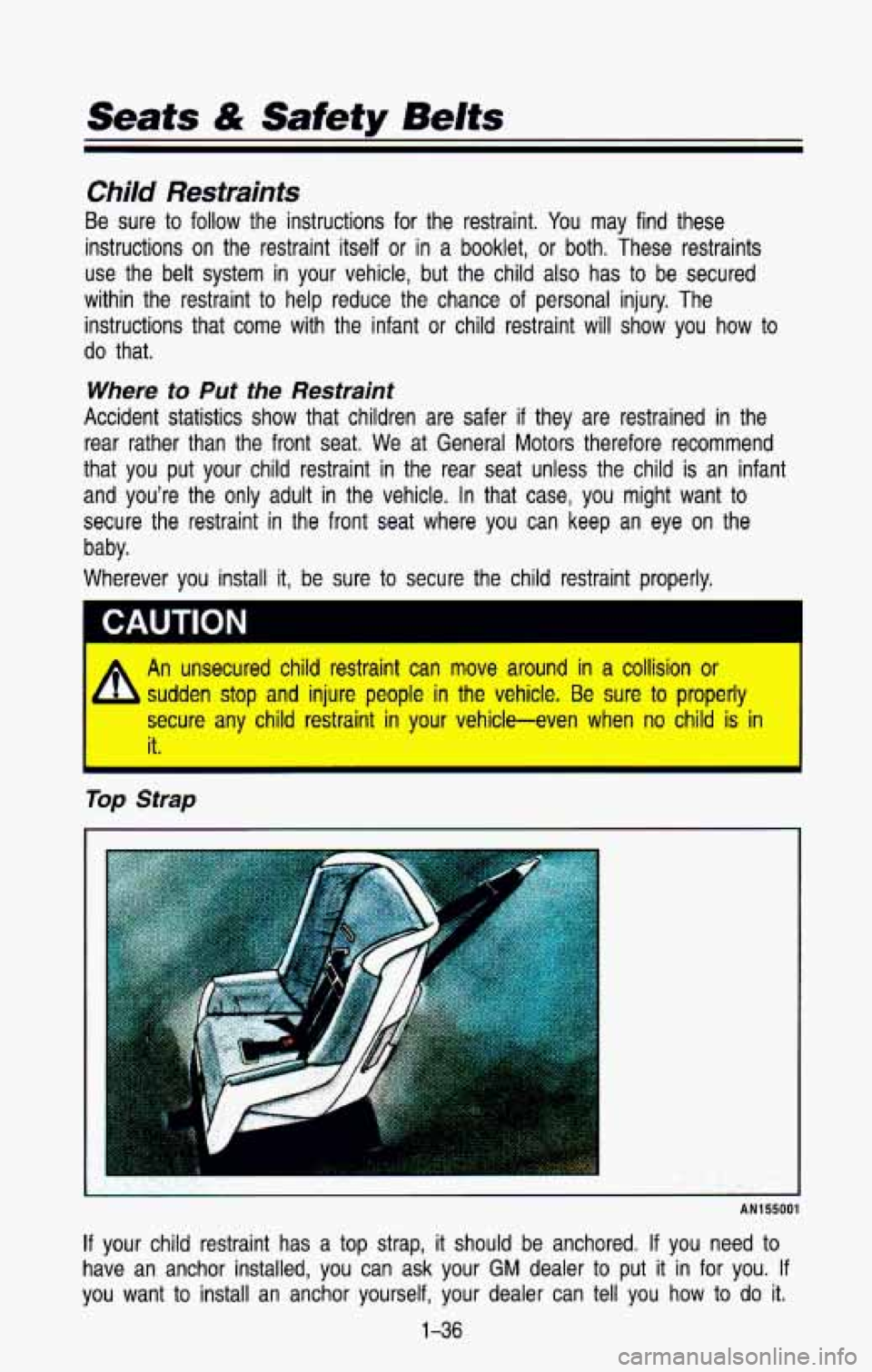
Seats & Safety Belts
Child Restraints
Be sure to follow the instructions for the restraint. You may find these
instructions on the restraint itself or in a booklet, or both. These restraints
use the belt system in your vehicle, but the child also has to be secured
within the restraint
to help reduce the chance of personal injury. The
instructions that come with the infant or child restraint will show you how to
do that.
Where to Put the Restraint
Accident statistics show that children are safer if they are restrained in the
rear rather than the front seat. We at General Motors therefore recommend
that
you put your child restraint in the rear seat unless the child is an infant
and you’re the only adult in the vehicle. In that case, you might want to
secure the restraint in the front seat where you can keep an \
eye
on the
baby.
Wherever
you install it, be sure to secure the child restraint properly.
CAUTION
I A An unsecured child restraint can move around in a collision or
A sudden stop and injure people in the vehicle. Be sure to properly
secure any child restraint in your vehicle-even when no child is in
it.
Top Strap
AN1 55001
If your child restraint has a top strap, it should be anchored. If you need to
have an anchor installed, you can ask your
GM dealer to put it in for you. If
you want to install an anchor yourself, your dealer can tell you how to do it.
1-36
Page 50 of 386
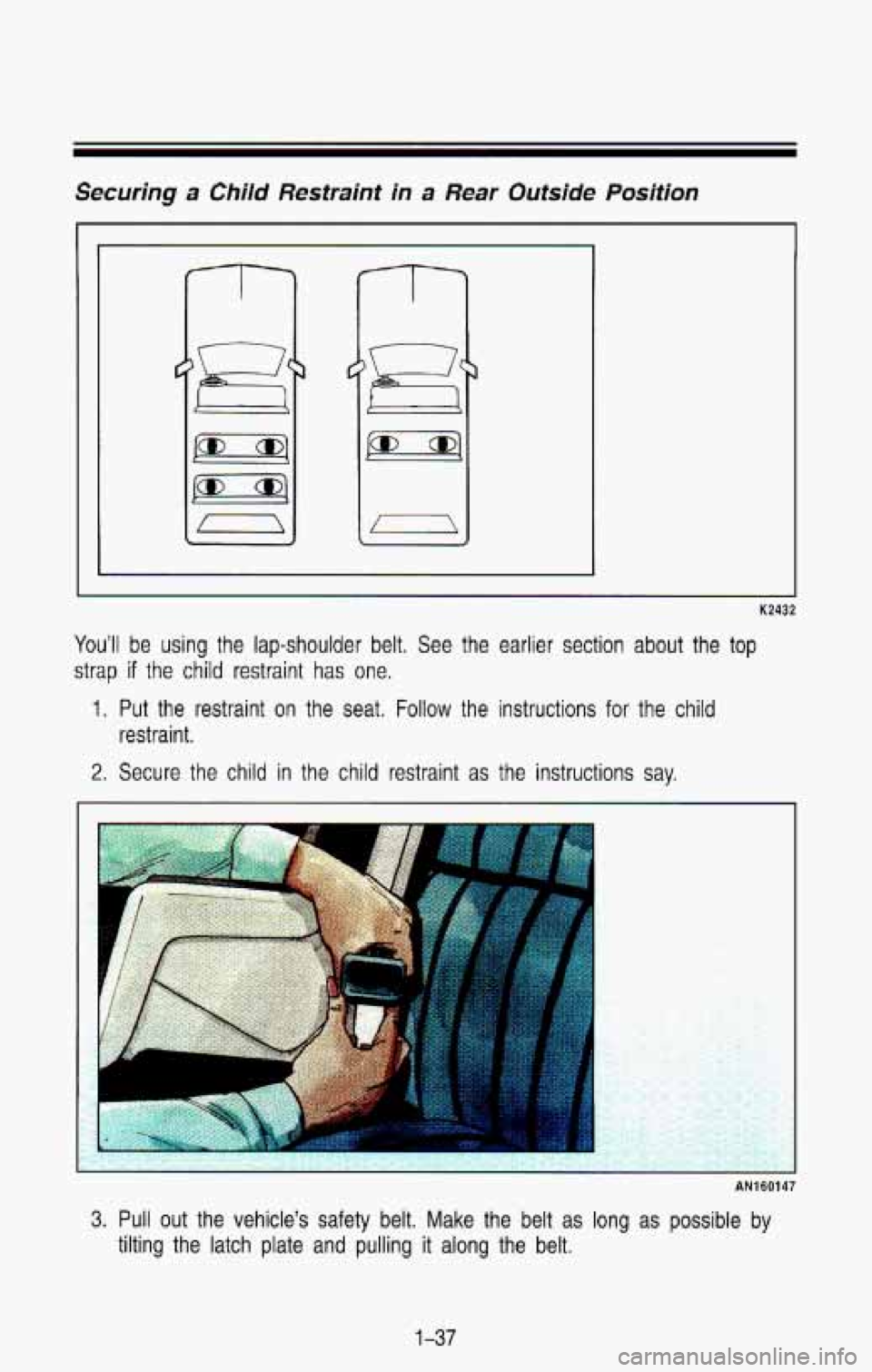
Securing a Child Restraint in a Rear Outside Position
I
--I-
K2432
You’ll be using the lap-shoulder belt. See the earlier section about the \
top
strap if the child restraint has one.
1. Put the restraint on the seat. Follow the instructions for the child
2. Secure the child in the child restraint as the instructions sa\
y. restraint.
I
AN160147
3. Pull out the vehicle’s safety belt. Make the belt as long as possible by
tilting the latch plate and pulling
it along the belt.
1-37